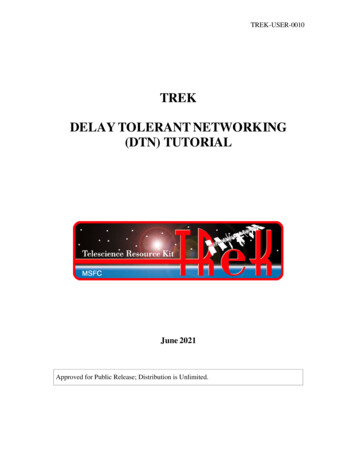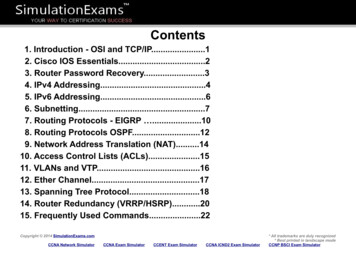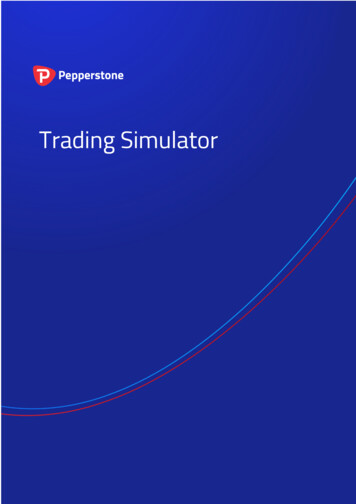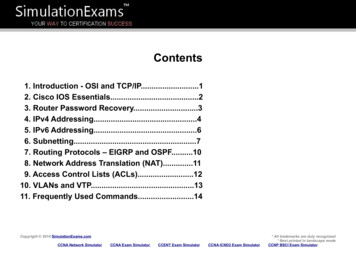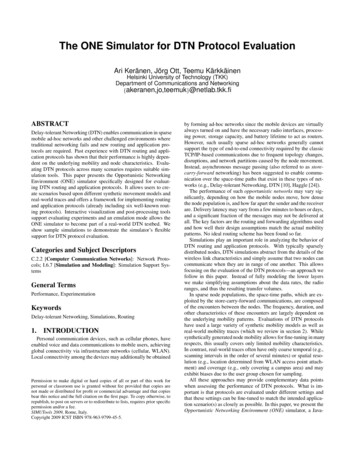
Transcription
The ONE Simulator for DTN Protocol EvaluationAri Keränen, Jörg Ott, Teemu KärkkäinenHelsinki University of Technology (TKK)Department of Communications and CTDelay-tolerant Networking (DTN) enables communication in sparsemobile ad-hoc networks and other challenged environments wheretraditional networking fails and new routing and application protocols are required. Past experience with DTN routing and application protocols has shown that their performance is highly dependent on the underlying mobility and node characteristics. Evaluating DTN protocols across many scenarios requires suitable simulation tools. This paper presents the Opportunistic NetworkingEnvironment (ONE) simulator specifically designed for evaluating DTN routing and application protocols. It allows users to create scenarios based upon different synthetic movement models andreal-world traces and offers a framework for implementing routingand application protocols (already including six well-known routing protocols). Interactive visualization and post-processing toolssupport evaluating experiments and an emulation mode allows theONE simulator to become part of a real-world DTN testbed. Weshow sample simulations to demonstrate the simulator’s flexiblesupport for DTN protocol evaluation.Categories and Subject DescriptorsC.2.2 [Computer Communication Networks]: Network Protocols; I.6.7 [Simulation and Modeling]: Simulation Support SystemsGeneral TermsPerformance, ExperimentationKeywordsDelay-tolerant Networking, Simulations, Routing1.INTRODUCTIONPersonal communication devices, such as cellular phones, haveenabled voice and data communications to mobile users, achievingglobal connectivity via infrastructure networks (cellular, WLAN).Local connectivity among the devices may additionally be obtainedPermission to make digital or hard copies of all or part of this work forpersonal or classroom use is granted without fee provided that copies arenot made or distributed for profit or commercial advantage and that copiesbear this notice and the full citation on the first page. To copy otherwise, torepublish, to post on servers or to redistribute to lists, requires prior specificpermission and/or a fee.SIMUTools 2009, Rome, Italy.Copyright 2009 ICST ISBN 978-963-9799-45-5.by forming ad-hoc networks since the mobile devices are virtuallyalways turned on and have the necessary radio interfaces, processing power, storage capacity, and battery lifetime to act as routers.However, such usually sparse ad-hoc networks generally cannotsupport the type of end-to-end connectivity required by the classicTCP/IP-based communications due to frequent topology changes,disruptions, and network partitions caused by the node movement.Instead, asynchronous message passing (also referred to as storecarry-forward networking) has been suggested to enable communication over the space-time paths that exist in these types of networks (e.g., Delay-tolerant Networking, DTN [10], Haggle [24]).The performance of such opportunistic networks may vary significantly, depending on how the mobile nodes move, how densethe node population is, and how far apart the sender and the receiverare. Delivery latency may vary from a few minutes to hours or days,and a significant fraction of the messages may not be delivered atall. The key factors are the routing and forwarding algorithms usedand how well their design assumptions match the actual mobilitypatterns. No ideal routing scheme has been found so far.Simulations play an important role in analyzing the behavior ofDTN routing and application protocols. With typically sparselydistributed nodes, DTN simulations abstract from the details of thewireless link characteristics and simply assume that two nodes cancommunicate when they are in range of one another. This allowsfocusing on the evaluation of the DTN protocols—an approach wefollow in this paper. Instead of fully modeling the lower layerswe make simplifying assumptions about the data rates, the radioranges, and thus the resulting transfer volumes.In sparse node populations, the space-time paths, which are exploited by the store-carry-forward communications, are composedof the encounters between the nodes. The frequency, duration, andother characteristics of these encounters are largely dependent onthe underlying mobility patterns. Evaluations of DTN protocolshave used a large variety of synthetic mobility models as well asreal-world mobility traces (which we review in section 2). Whilesynthetically generated node mobility allows for fine-tuning in manyrespects, this usually covers only limited mobility characteristics.In contrast, real-world traces often have only coarse temporal (e.g.,scanning intervals in the order of several minutes) or spatial resolution (e.g., location determined from WLAN access point attachment) and coverage (e.g., only covering a campus area) and mayexhibit biases due to the user group chosen for sampling.All these approaches may provide complementary data pointswhen assessing the performance of DTN protocols. What is important is that protocols are evaluated under different settings andthat these settings can be fine-tuned to match the intended application scenario(s) as closely as possible. In this paper, we present theOpportunistic Networking Environment (ONE) simulator, a Java-
based tool offering a broad set of DTN protocol simulation capabilities in a single framework, designed based upon our experiencefrom analyzing numerous DTN routing and application protocols.1Our contributions are twofold: 1) The ONE simulator offers an extensible simulation framework itself supporting mobility and eventgeneration, message exchange, DTN routing and application protocols, a basic notion of energy consumption, visualization and analysis, interfaces for importing and exporting mobility traces, events,and entire messages. 2) Using this framework, we implementedan extensive set of ready-to-use modules: six synthetic mobilitymodels that can be parameterized and combined to approximatereal-world mobility scenarios, six configurable well-known DTNrouting schemes, a set of base primitives to design application protocols, a basic battery and energy consumption model, several input/output filters for interacting with other simulators, and a mechanism for the integration with real-world testbeds. The ONE simulator is designed in a modular fashion, allowing extensions of virtually all functions to be implemented using well-defined interfaces.This paper is structured as follows: In section 2, we review related work on DTNs and (related) simulations for mobility. Weintroduce the architecture and different features of the ONE simulator in depth in section 3 and describe how ONE is used in emulation setups in section 4. We show example simulation results andcomment on the simulator’s performance in section 5. Section 6concludes this paper with a summary and points out future work.2.RELATED WORKIn this paper, we focus on communication performance in delaytolerant ad-hoc networks comprising mobile nodes. Delay-tolerantNetworking [10] is increasingly applied to enable communicationin challenging networking environments, including sparse sensornets and opportunistic mobile ad-hoc networks. The DTNRG architecture [5] proposes a bundle layer as an overlay to bridge different (inter)networks. Nodes communicate via asynchronous messages of arbitrary size that are exchanged using the store-carry-andforward paradigm. Messages have a finite TTL and are discardedwhen the TTL expires. They may also get dropped by a node dueto congestion, yielding a best-effort service. Application protocolsneed to tolerate the delays resulting from the challenged environment and the risk that messages are not delivered in time or notat all. Typical performance metrics for evaluating DTN protocolperformance are hence message delivery probability and latency.Numerous routing and forwarding schemes have been proposedover the past years (refer to [32] and [21] for overviews). Differentmechanisms are usually applied depending on whether the networkis primarily of mobile ad-hoc nature (e.g., mobile devices carriedby humans) or is based upon a (fixed or mobile) infrastructure (e.g.,space networks, bus networks). Obviously, mixed networks exist aswell (e.g., mobile users supported by infrastructure nodes).The primary difference between various DTN routing protocolsis the amount of information they have available to make forwarding decisions [13]. Ad-hoc DTNs usually apply variants of reactiveprotocols. Flooding protocols such as epidemic routing [30] do notuse any information. Predictive protocols such as PRoPHET [19]use past encounters of nodes to predict their future suitability todeliver messages to a certain target whereas other protocols alsoexploit further (explicitly configured) schedule and context information per node [18]. Furthermore, they differ in their replicationstrategies, i.e., how many copies of a message they create which,in turn, has a direct impact on the load incurred on the network.Some protocols generate just a single copy [27] (e.g., First Contact1This paper is based upon and extends our technical report [17].[13], Direct Transmission/Delivery [27]), others a fixed numberlimited by the sender [28] [26] while epidemic [30] and probabilistic [19] routing potentially create an “infinite” number of messages.Scheduling strategies govern in which order messages are passedwhen a communication opportunity occurs between two nodes. Finally, queue management strategies define when and which messages are deleted, e.g., if congestion occurs.For evaluating the performance of DTN routing protocols, manifold settings have been used, mostly including some type of nodemobility. Mobility has been created (a) from synthetic mobilitymodels, (b) taken from traces obtained from real-world measurements, and (c) by evaluating code in the real-world. While a fewtestbeds for (c) exist (such as DieselNet [3]) their flexibility is usually limited, large-scale operation “expensive”, and their use is typically limited to those running the testbed. Such testbeds may alsobe used to obtain real-world traces (b) which can then be madeavailable to other researchers.Various projects have collected traces of contacts (peers, times,durations, and possibly positions) between Bluetooth devices [11],between users and/or wireless access points [8], among others. TheCRAWDAD project2 provides a repository where numerous realworld traces are available.3 These traces offer insights into realworld interactions between mobile users from different angles andconstitute a valuable data source for validating the mobility andconnectivity characteristics obtained from synthetic models.But also real-world traces have their limitations as—so far—thepopulation analyzed in these traces is naturally very limited andmay thus bias the results. Furthermore, the time granularity is often limited in order not to drain mobile device batteries too quickly:e.g., the Haggle iMotes uses sensing intervals of 5 min so that manycontact opportunities may easily go undetected and contact durations can only be assessed equally coarsely. While this can be seento reflect energy constraints, the scanning interval cannot be adjusted afterwards. Finally, the results cannot be arbitrarily scaled,thus limiting what can be evaluated.The only option for flexible and scalable simulations is thus (a)model-based synthetic mobility generation.4 Mobility models rangefrom simple entity models such as Random Waypoint to complexones such as Random Trip [2] to group mobility to communitymodels with major points of interest [4] to vehicular ones takingstreet maps into account (e.g., [6]). Node velocity and pause timesmay be adjusted to match pedestrians, vehicles, or other node typesand smooth turns, acceleration and deceleration may be added toobtain more realistic behavior [1]. Specific models for vehicularnetworking furthermore consider additional constraints from simple road setups to real-world maps on one hand and simple noninterfering vehicles to vehicular interaction (distance, speed) basedupon traffic flow models on the other. Approximations for footpath construction in and around buildings are used to make motionmore realistic and transmission range and performance is adaptedto model walls between mobile nodes [14].In other areas (e.g., for epidemic spreading studies or traffic planning), more complex simulation models have been created mimicking the behavior of the population of an entire city [20]. Dependingon the precise setting, the latter may not have the proper focus forevaluating ad-hoc interpersonal communications: TRANSIMS, forexample, allows modeling a population and their interaction at certain locations or in vehicles, but does not include details on the waybetween such locations, which limits the suitability of the generated2http://crawdad.cs.dartmouth.edu/The DieselNet traces are available at http://traces.cs.umass.edu.4For an overview, see, e.g., [1, 4, 9] and the references therein.3
mobility data of pedestrians. In the case of TRANSIMS, detailedvehicle information could be made available and has been used forinvestigating MANET protocols [20].Mobility generators for simple models are available for ns-2 andns-3, as part of their respective toolsets or as specific extensions(e.g., [2]); both ns-2 and ns-3 accept suitably converted traces asinput.5 The latter also holds for various openly available DTN simulators (dtnsim [13] and dtnsim26 ) and numerous ones tailored tospecific research needs, based upon OMNet , OPNET, or entirelynewly developed7 , all of which have rather limited support for DTNrouting protocols readily available. While ns-2 (and now ns-3)and OMNet offer sound generic open simulation platforms forpacket-based communications and tools such as JANE [7] providespecific support for MANETs, generic support for DTN simulationis overall fairly limited. The ONE simulator contributes an environment for DTN protocol evaluation, embedding internal and externalmobility models, different DTN routing schemes, and interactiveinspection (similar to nsnam for ns-2) as well as post-processing.3.THE ONE SIMULATORAt its core, ONE is an agent-based discrete event simulation engine. At each simulation step the engine updates a number of modules that implement the main simulation functions.The main functions of the ONE simulator are the modeling ofnode movement, inter-node contacts, routing and message handling. Result collection and analysis are done through visualization, reports and post-processing tools. The elements and theirinteractions are shown in figure 1. A detailed description of thesimulator is available in [16] and the ONE simulator project page[29] where the source code is also available.Node movement is implemented by movement models. Theseare either synthetic models or existing movement traces. Connectivity between the nodes is based on their location, communicationrange and the bit-rate. The routing function is implemented by routing modules that decide which messages to forward over existingcontacts. Finally, the messages themselves are generated throughevent generators. The messages are always unicast, having a singlesource and destination host inside the simulation world.Simulation results are collected primarily through reports generated by report modules during the simulation run. Report modulesreceive events (e.g., message or connectivity events) from the simulation engine and generate results based on them. The results generated may be logs of events that are then further processed by theexternal post-processing tools, or they may be aggregate statisticscalculated in the simulator. Secondarily, the graphical user interface (GUI) displays a visualization of the simulation state showingthe locations, active contacts and messages carried by the nodes.3.1Node CapabilitiesThe basic agents in the simulator are called nodes. A node models a mobile endpoint capable of acting as a store-carry-forwardrouter (e.g., a pedestrian, car or tram with the required hardware).Simulation scenarios are built from groups of nodes in a simulationworld. Each group is configured with different capabilities.Each node has a set of basic capabilities that are modeled. Theseare radio interface, persistent storage, movement, energy consumption and message routing. Node capabilities such as the radio interface and persistent storage that involve only simple modeling a/DTN/sim/7E.g., Pydtn at http://www.umiacs.umd.edu/ mmarsh/pydtn/ andhttp://www-net.cs.umass.edu/ ellenz/software.html.6movement modelsMap-based movementExternal traceroutingRandom waypointexternal DTNrouting rnal routinglogicetc.event generatorsExternal events filevisualization,reports, etc.Message event generatorpost processors(e.g. graphviz)graphs,charts,etc.visualization and resultsetc.Figure 1: Overview of the ONE simulation environmentconfigured through parametrization (e.g., communication range, bitrate, peer scanning interval and storage capacity). More complexcapabilities such as movement and routing are configured throughspecialized modules that implement a particular behavior for thecapability (e.g., different mobility models).Modules in each node have access to the node’s basic simulation parameters and state, including the position, current movementpath, and current neighbors. This allows implementing, e.g., geographic routing and other context-specific algorithms. In addition,modules can make any of their parameters available for other modules in the same node through an intermodule communication bus.This way, for example, a movement module can change its behavior depending on the router module’s state or a router module canadjust the radio parameters based on the node intercontact times.The focus of the simulator is on modeling the behavior of storecarry-forward networking, and hence we deliberately refrain fromdetailed modeling of the lower layer mechanisms such as signal attenuation and congestion of the physical medium. Instead, the radiolink is abstracted to a communication range and bit-rate. These arestatically configured and typically assumed to remain constant overthe simulation. However, the context awareness and dynamic linkconfiguration mechanisms can be used to adjust both range and bitrate depending on the surroundings, the distance between peers andthe number of (active) nodes nearby as suggested, e.g., in [14].The node energy consumption model is based on an energy budget approach. Each node is given an energy budget which is spentby energy consuming activities such as transmission or scanningand can be filled by charging in certain locations (e.g., at home).An inquiry mechanism allows other modules to obtain energy levelreadings and adjust their actions (e.g., scanning frequency as in[31], forwarding activity, or transmission power) accordingly.Node movement capabilities are explained below in section 3.2and the message routing capabilities in section 3.3.3.2Mobility ModelingNode movement capabilities are implemented through mobilitymodels. Mobility models define the algorithms and rules that generate the node movement paths. Three types of synthetic movementmodels are included: 1) random movement, 2) map-constrainedrandom movement, and 3) human behavior based movement.The simulator includes a framework for creating movement models as well as interfaces for loading external movement data (see3.5). Implementations of popular Random Walk (RW) and RandomWaypoint (RWP) are included. While these models are popular dueto their simplicity, they have various known shortcomings [4].To better model real-world mobility, map-based mobility con-
strains node movement to predefined paths and routes derived fromreal map data. Further realism is added by the Working Day Movement (WDM) model [9] that attempts to model typical human movement patters during working weeks.3.2.1Map-Based MobilityMap-based movement models constrain the node movement topaths defined in map data. The ONE simulator release includesthree map-based movement models: 1) Random Map-Based Movement (MBM), 2) Shortest Path Map-Based Movement (SPMBM),and 3) Routed Map-Based Movement (RMBM). Furthermore, therelease contains map data of the Helsinki downtown area (roadsand pedestrian walkways) that the map-based movement modelscan use. However, the movement models understand arbitrary mapdata defined in (a subset of) Well Known Text (WKT). Such datais typically converted from real-world map data or created manually using Geographic Information System (GIS) programs such asOpenJUMP.8In the simplest map-based model, MBM, nodes move randomlybut always follow the paths defined by the map data. This resultsin a random walk of the network defined by the map data and thusmay not be a very accurate approximation of real human mobility.A more realistic model is the SPMBM where, instead of a completely random walk, the nodes choose a random point on the mapand then follow the shortest route to that point from their current location. The points may be chosen completely randomly or from alist of Points of Interest (POI). These POIs may be chosen to matchpopular real-world destinations such as tourist attractions, shopsor restaurants. Finally, nodes may have pre-determined routes thatthey follow, resulting in the RMBM model. Such routes may beconstructed to match, e.g., bus, tram or train routes.3.2.2Working Day Movement Model (WDM)While high-level movement models such as RWP, MBM, andSPMBM are simple to understand and efficient to use in simulations they do not generate inter-contact time and contact time distributions that match real-world traces, especially when the numberof nodes in the simulation is small. In order to increase the realityof (human) node mobility, we have developed the Working DayMovement (WDM) model [9] for ONE.The WDM model brings more reality to the node movement bymodeling three major activities typically performed by humans during a working week: 1) sleeping at home, 2) working at the office,and 3) going out with friends in the evening. These three activities are divided into corresponding sub-models between which thesimulated nodes transition depending on the time of the day.Beyond the activities themselves, the WDM model includes threedifferent transport models. The nodes can move alone or in groupsby walking, driving or riding a bus. The ability to move alone or ingroups at different speeds increases the heterogeneity of movementwhich has impact on the performance of, e.g., routing protocols.Finally, WDM introduces communities and social relationshipswhich are not captured by simpler models such as RWP. The communities are composed from nodes which work in the same office,spend time in the same evening activity spots or live together.We have shown that the inter-contact time and contact time distributions generated by the WDM model follow closely the onesfound in the traces from real-world measurements [9].3.3RoutingThe message routing capability is implemented similarly to themovement capability: the simulator includes a framework for defin8http://openjump.orging the algorithms and rules used in routing and comes with readyimplementations of well known DTN routing protocols.There are six included routing protocols: 1) Direct Delivery (DD),2) First Contact (FC), 3) Spray-and-Wait, 4) PRoPHET, 5) MaxProp, and 6) Epidemic. This selection covers the most important classes of DTN routing protocols: single-copy, n-copy andunlimited-copy protocols, as well as estimation based protocols.Direct Delivery and First Contact are single-copy routing protocols where only one copy of each message exists in the network. InDirect Delivery, the node carries messages until it meets their finaldestination. In First Contact routing the nodes forward messagesto the first node they encounter, which results in a “random walk”search for the destination node.Spray-and-Wait [28] is an n-copy routing protocol that limits thenumber of message copies created to a configurable maximum anddistributes (“sprays”) these copies to contacts until the number ofcopies is exhausted. Both variants of Spray-and-Wait suggested byits authors are included: in normal mode, a node gives one copy toa contact, in binary mode half of the copies are forwarded. Onceonly a single copy is left, it is forwarded only to the final recipient.Three routing protocols perform variants of flooding. Epidemic[30] replicates messages to all encountered peers, while PRoPHET[19] tries to estimate which node has the highest “likelihood” ofbeing able to deliver a message to the final destination based onnode encounter history. MaxProp [3] floods the messages but explicitly clears them once a copy gets delivered to the destination. Inaddition, MaxProp sends messages to other hosts in specific orderthat takes into account message hop counts and message deliveryprobabilities based on previous encounters.Routing capabilities of simulators such as ns-2 or dtnsim2 canalso be used in conjunction with ONE. Report modules can exportmobility and connectivity data to other programs (modules for ns2 and dtnsim2 are included) and external scripts are then used toimport the results of routing simulation back into ONE (script fordtnsim2 is included).If the external routing simulation was run with a contact schedule created by the ONE simulator, as described in section 3.6, thewhole process from node movement to external simulator’s routingdecisions can be visualized and inspected using ONE.Adding Routing ProtocolsTo evaluate new routing protocols in the ONE simulator, a newrouting module needs to be created for the respective protocol. Allrouting modules inherit basic functionality, such as simple buffermanagement and callbacks for various message-related events, fromthe MessageRouter module. These callbacks are invoked by thesimulator engine for all kinds of events, e.g., when a new messageis created or a message is sent to the node. A router module needsto handle these events and also define actions to be carried out atevery time step and the behavior when a new node comes into orleaves the node’s radio range.The basic functionality for all these events is common for the allcurrently implemented routing modules with internal routing logic.It is simply re-used for new routing protocols by extending the ActiveRouter module. This module provides functions for checkingif any of the currently buffered messages are destined to a neighboring node, offering sets of messages to neighboring nodes, anddealing with successfully transferred and aborted message transfers, and it implements FIFO and random-ordering buffer management. For Epidemic, DD and FC routers no functionality beyondthis is needed, making their implementations straightforward.More advanced routing modules may need to track node contacts and therefore implement the node discovery callback; e.g.,
PRoPHET and MaxProp perform their own book-keeping on pastencounters. State may also be attached to messages using a taggingmechanism and thereby routing information may be forwarded acrossthe network. For example, the Spray-and-Wait router uses thismechanism to include a copy count in every message.When a simulation is run with the new routing module, the reportmodules gather the same performance data of the routing processas they do with the existing modules, so that comparing the performance of the new module to the existing ones is straightforward.3.4Application SupportThe ONE simulator provides two ways to generate applicationmessages inside the simulation: 1) message generators, and 2) external event files. Messages may be unidirectional or generate replieswhen they are received, approximating a request-response type application. Furthermore, the messages may include application specific information through generic (name, value) pairs attached tothem.The built-in message generator creates messages with a randomor fixed source, destination, size, and interval. A separate tool forgenerating message event files is also included. Any number ofsuch message event sources may be used concurrently in simulations. Messages are either unidirectional or tagged to expect a response, with separate control of the response size.Application-specific headers and payloads may be attached tothe messages and nodes may be extended to support inspectingmessage headers and contents along the way so that applicationaware forwarding can be realized, e.g., for content distribution.3.593.6Reporting and VisualizationONE is able to visualize results of the simulation in two ways:via an interactive Graphical User Interface (GUI) and by generatingimages from the information gathered during the simulation.Figure 2 shows the GUI displaying the simulation in real-time.Node locations, current paths, connections between nodes, numberof messages carried by a node, etc. are all visualized in the mainwindow. If a map-based movement model is used, also all the mappaths are shown. An additional background image (e.g., a rastermap or a satellite image of the simulation area) is shown below themap paths if available. The view allows zooming and interactiveadjusting of the simulation speed.InterfacesAn important feature of ONE is its ability to interact with otherprograms and data sources. The simulator has interfaces, e.g., fornode movement, connectivity and message routing traces.It is possible to generate node movement using an external program, such as TRANSIMS or BonnMotion9 , or from a real-worldGPS trace such as the ones available from CRAWDAD. Such atrace file needs to be converted to a suitable form for the External Movement module. The distribution package contains a simplescript that can convert TRANSIMS output to this format.
works (e.g., Delay-tolerant Networking, DTN [10], Haggle [24]). The performance of such opportunistic networks may vary sig-nificantly, depending on how the mobile nodes move, how dense the node population is, and how far apart the sender and the receiver are. Delivery latency may vary from a few minutes to hours or days,


